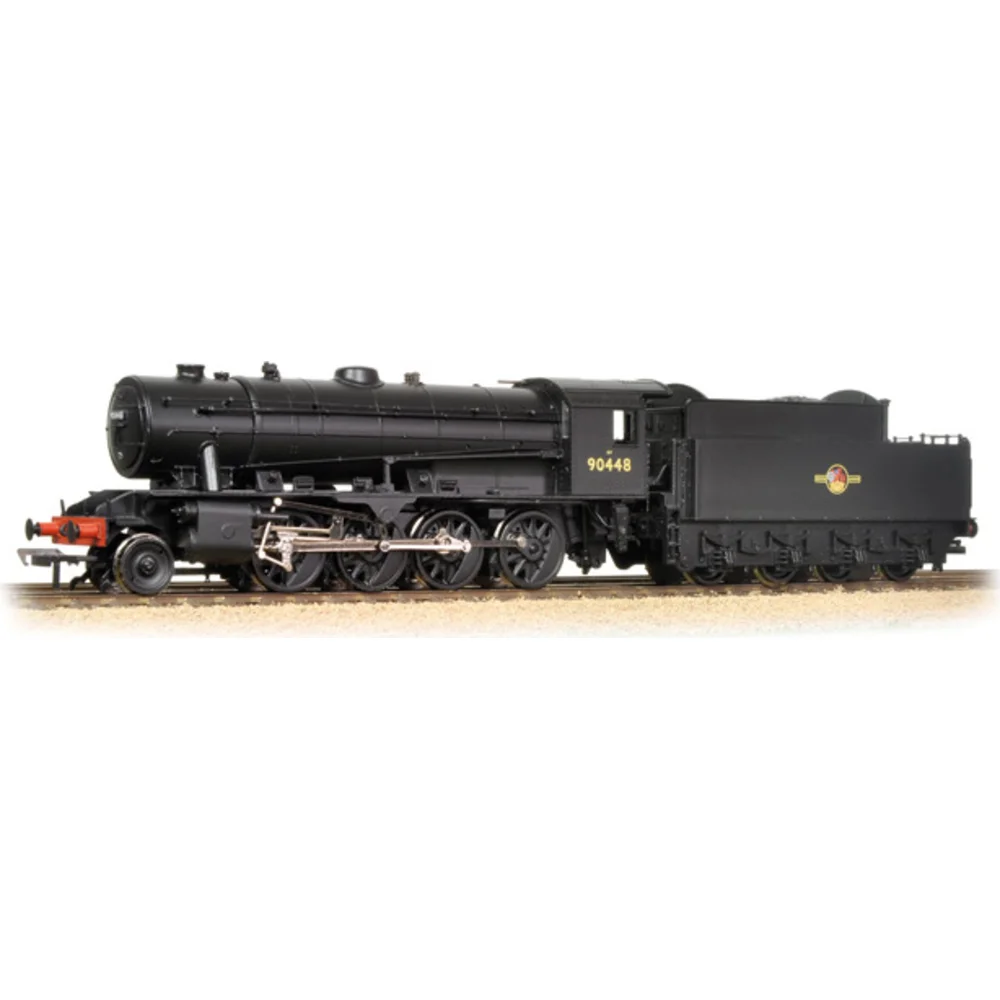Bachmann 32-260DC
War Department Austerity 2-8-0 90448 British Railways Black with Late Crest
Tooling
In 2012, Bachmann Branchline released a significantly upgraded version of its OO gauge War Department Austerity 2-8-0. This retooling replaced the original 1996 tooling and addressed many of the limitations of the earlier model, aligning it with contemporary expectations for detailing, performance, and digital control. The upgrade was part of Bachmann’s ongoing effort to modernise its range and improve fidelity to prototype and operational standards.
Tooling Features
- Scale: OO gauge (1:76)
- Construction: Plastic bodyshell with separately fitted fine details; metal chassis
- Detailing: Factory-fitted handrails, lamp irons, pipework, smokebox door dart, safety valves, cab interior, and etched nameplates on select models
- Couplings: NEM pockets with tension-lock couplers; sprung buffers
Mechanical & Electrical
- Motor: 3-pole motor located in the locomotive
- Drive: Loco-driven wheels with all-wheel pickup
- Minimum Radius: Compatible with second radius curves (approx. 438mm)
- Lighting: Directional lighting on some models; provision for lamps via decoder functions
- Weighting: Balanced weight distribution in loco and tender for improved traction
DCC Capability
The 2012 tooling introduced full DCC readiness with a 21-pin socket located in the tender. This allowed for straightforward decoder installation and enabled sound-fitted versions using ESU LokSound V5 decoders. Models with sound included a wide range of functions such as playable whistles, injectors, firebox door effects, and shunting mode.
Liveries Produced
Several liveries were produced using the 2012 tooling, including:
- Longmoor Military Railway Blue
- LNER Black
- BR Black (early and late crests)
- War Department Khaki
Reviews
Reviews of the retooled model were generally positive. Enthusiasts praised the improved detailing, smoother running, and ease of DCC installation. Sound-fitted versions received particular acclaim for their immersive audio experience. Some users noted minor issues with tight body fitting and occasional short circuits when reassembling, typically resolved with careful insulation.
Media & Commentary
The upgraded model has been featured in numerous YouTube reviews and layout showcases. Social media commentary highlights the model’s improved realism and performance, with many users considering it a worthwhile upgrade over the original tooling. Forum discussions often compare the new version favourably to other contemporary releases, especially in terms of finish and sound quality.
Additional Notes
- Accessory packs included additional pipework and bufferbeam details
- Removable coal load with modelled coal space beneath
- Some models included adjustable tender drawbars for closer coupling
- Sound-equipped models supported analogue operation with automatic sound playback
Class & Prototype
- Class: War Department Austerity 2-8-0
- Traction: Steam
- Built: 1943-1945
- Total Built: 935
No prototype found.
Operator & Livery
- Operator: British Railways
- Livery: Black with Late Crest
British Railways transformed Britain's fragmented rail network into a unified national system following nationalisation on 1st January 1948. Created from the "Big Four" companies under the Transport Act 1947, BR operated most of Great Britain's railways until rebranding as British Rail in 1965, managing over 20,000 route miles and inheriting nearly 20,000 locomotives of diverse designs.
The organisation pioneered standardisation through its revolutionary BR Standard locomotive programme (1951-1960), producing 999 advanced steam engines under Robert Riddles' direction. These included the versatile Britannia Pacifics, mighty 9F freight engines, and mixed-traffic classes that incorporated the best features from all predecessor companies. The 1955 Modernisation Plan accelerated diesel and electric traction development, creating fascinating mixed-traction operations.
Notable achievements included establishing unified locomotive classification systems, introducing distinctive corporate liveries, and managing the complex transition from steam to modern traction. BR's six regional structure preserved operational diversity whilst enabling standardisation of practices, signalling, and rolling stock that had eluded private enterprise for over a century.
The BR era represents steam traction's final flowering alongside emerging diesel technology, creating unparalleled locomotive variety. Today, this heritage remains highly popular with railway enthusiasts through extensive preserved fleets, heritage railway operations, and comprehensive model ranges from manufacturers like Hornby, Bachmann, and Dapol, making BR subjects essential for authentic post-war British railway modelling across all scales.
British Railways' plain black livery remained the standard finish for freight and shunting locomotives from 1956 onwards, representing the most economical and practical scheme for inherently dirty industrial operations. Plain black locomotives retained red buffer beams and received white lettering in Gill Sans style, maintaining the utilitarian approach established in the early BR period. The livery was applied to a vast range of locomotive types, from powerful freight engines like the 9F class down to humble shunting locomotives and industrial engines working in goods yards, collieries, and freight terminals.
From 1956, these locomotives received the new "Lion and Crown" emblem (nicknamed the "Ferret and Dartboard"), a proper heraldic device featuring a rampant lion emerging from a crown and holding a spoked wheel, enclosed in a roundel with "British Railways" displayed on bars either side. Unlike earlier practice, the new emblem was positioned centrally on tender sides or tank sides without reference to axle boxes, following heraldic conventions with the lion facing left. This livery period coincided with increasing neglect as steam operations wound down, with locomotives often covered in layers of grime that obscured the paintwork and made the already austere black finish appear even more weathered. The plain black finish continued until individual locomotives were withdrawn from service, with many examples lasting into the final years of steam operation in 1968. For modellers, this livery represents the twilight of steam freight operations, capturing the workaday reality of British Railways' industrial locomotive fleet during the final phase of steam traction.
